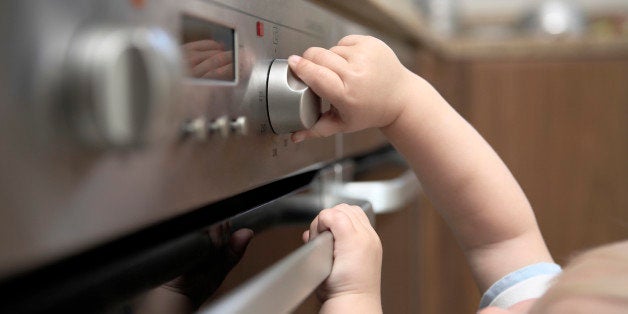
Baby's on the move? Run! No wait, better make sure it's safe. Here's a checklist for all you parents, grandparents, godparents, aunts, uncles and friends who have little ones moving about your home. Curiosity can be adorable, but did you know how much trouble a child's sense of exploration can be? Unintentional child injury is actually the #1 cause of death of children between the ages of 1 and 4. I recently learned this very scary stat when I partnered with a professional childproofing service for our clients. I turned to the uber-knowledgeable folks at Safe Kids Worldwide to find out how we can change this terrifying fact and keep our little ones safe in our homes.
The good news is that 90% of those ER trips can be prevented, according to the safety experts at Safe Kids Worldwide. The other good news is that safety devices have come a long way in the past few years. There are more and more product choices for aesthetic-minded parents. Of course, safety comes first, but baby-proofing doesn't have to look ugly or be a nuisance to use!
The first step to a safe home, say the experts at Safe Kids, is to look at the world through your baby's eyes. See what looks interesting and what can be reached. And I mean it literally -- get down on your hands and knees and check for small things your baby can choke on like coins and small toy parts. You will be amazed at what you discover! One of my nephew's favorite pastimes was to crawl under the sofa and put odds and ends that were tucked behind the sofa leg, out of vacuum reach, into his mouth. Oh joy! Once, he found a petrified mini Oreo hung on a Christmas ornament hanger -- just what the baby needs to find, Oreo toddler/fish bait with hook and all! Yikes! I wouldn't have found that if I hadn't laid on my stomach and peered under the sofa.
Once you have identified and removed all of the easily reachable dangers, follow these critical steps from the Safe Kids experts to transform your home into a safe environment for your crawlers, toddlers, climbers and grabbers.
Baby Safety Checklist:
•Have working smoke alarms and carbon monoxide detectors inside all bedrooms, outside all sleeping areas and on every level of your home. Test alarms monthly and change batteries once a year.
•Install stair gates at the top and bottom of stairs. Stair gates at the top must be attached to the wall with hardware.
•Secure furniture to the wall to avoid tip overs.
•Use cordless window coverings.
•Install window guards on all windows above the first floor.
•Keep these out of reach: electrical cords, frayed or damaged cords, uncovered outlets, plastic bags, matches, lighters, candles, fireplaces, space heaters, irons, guns and small objects (like jewelry, buttons, pins, paper clips, nails, stones, etc.)
•Lock up medicines, vitamins, cleaning products, pet food, alcohol, poisonous plants and chemicals (like paint, gasoline, etc.) and store them high out of your baby's reach.
•All new cribs on the market today meet the safety standards of the Consumer Product Safety Commission (CPSC) and the Juvenile Products Manufacturers Association (JPMA). But, before getting a used crib, check to see if it has been recalled at www.recalls.gov. Also, look for the following suffocation and strangulation hazards:
- Sharp or jagged edges
- Missing, broken or loose parts
- Loose hardware
- Cut out designs in the headboard or footboard
- Crib slats more than 2 3/8 inches apart (width of a soda can)
- Corner post extension over 1/16 of an inch high
- Gaps larger than 2 fingers width between the sides of the crib and the mattress
- Drop side latches that could be easily released by your baby
•Soft bedding can suffocate a baby, blocking the baby's airway during sleep. Babies can suffocate when their faces become wedged against or buried in a mattress, pillow or other soft object. This can also happen when someone in the same bed rolls over onto them. Use a safe crib with a firm, tight-fitting mattress covered with a crib sheet and nothing else in it. To keep your baby warm, use a sleep sack (wearable blanket).
•Room-sharing is a safer option than having your baby sleep in bed with you. Place your baby's crib, play yard or bassinet in your room during the first 6 months for more convenient feeding and close contact.
•Lay your baby on his or her back to sleep to reduce the risk of SIDS (Sudden Infant Death Syndrome.)
•For bath time, set the temperature of your water heater at 120 degrees Fahrenheit and put anti-scald devices on faucets. These devices turn off the water if the temperature is too hot.
•If you are unsure if an item is a choking hazard, take an empty toilet paper roll and put the small object in it. If it fits completely into the roll, don't let children under 3 play with it. A toilet paper roll is close in size to a young child's fully expanded throat. Follow your mom's advice: better safe than sorry. If you're in doubt if it's safe, move it out! That goes for bigger items too -- if it's a safety hazard and you don't need it now, simply put it in storage.
Remember safety is a constant concern: Don't just do these steps once and forget about them. Be sure to do safety checks everywhere your little mover goes. (You know your mother-in-law will love your safety additions to her kitchen!) Your little one's sense of adventure is growing daily and so are her abilities to get into mischief. Always be on alert. And, why not assign one day a week to do a top to bottom safety once over with baby's newly learned skills in mind. How about Safety Saturday?
And, keep in mind every home has special features that are unique as well as common safety challenges. The above are solutions to common safety hazards found in most homes. Now let the learning through exploration begin and enjoy this precious time!
For more safety tips visit here.
